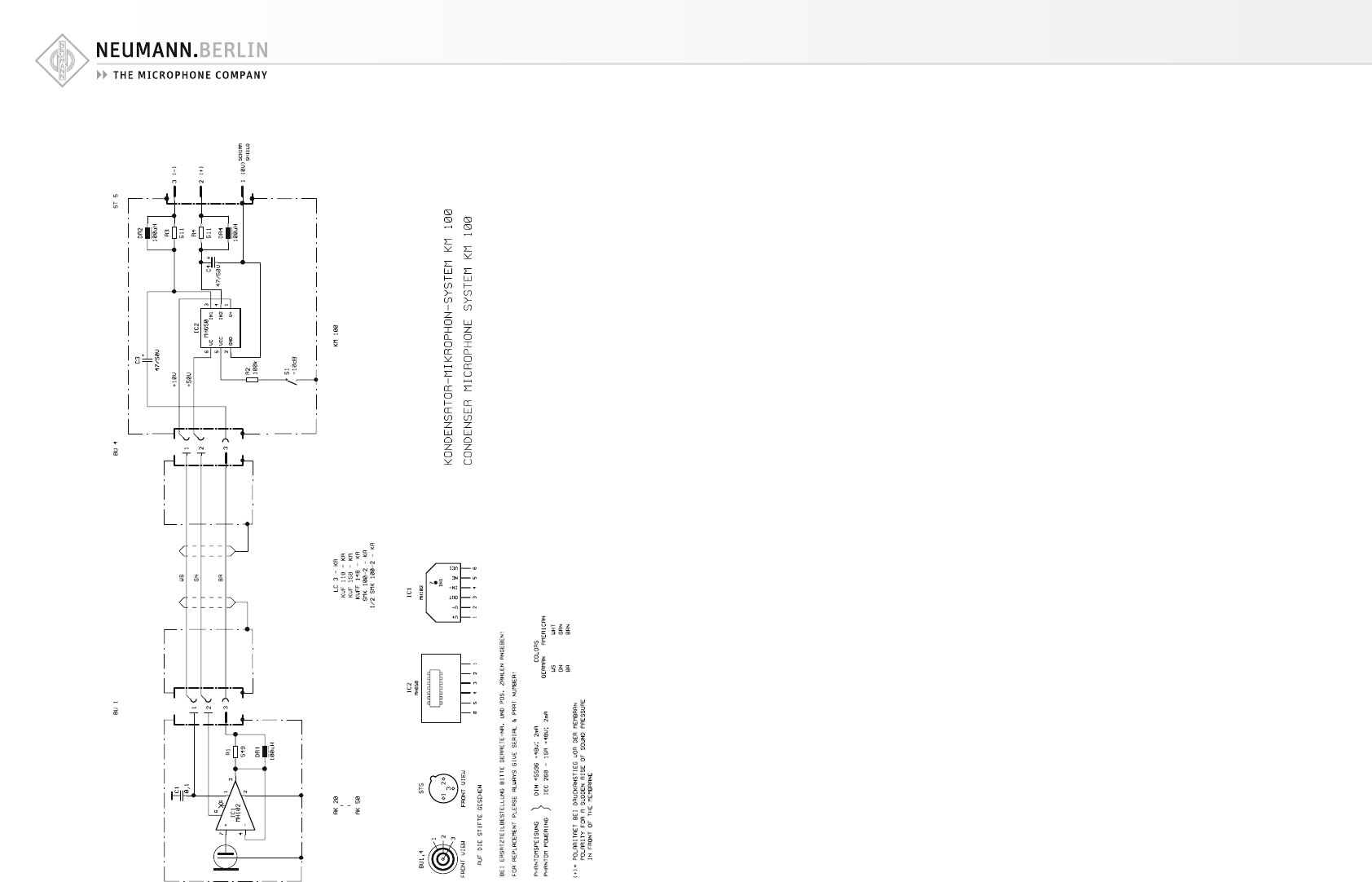
14 15
KM 100
6. Schaltbild / Circuit Diagram KM 100 7. Einige Hinweise zur Pflege von
Mikrophonen
Staubschutz verwenden: Mikrophone, die nicht im
Einsatz sind, sollte man nicht auf dem Stativ ein-
stauben lassen. Mit einem Staubschutzbeutel
(nicht fusselnd) wird dies verhindert. Wird ein Mi-
krophon längere Zeit nicht verwendet, sollte es
staubgeschützt bei normalem Umgebungsklima
aufbewahrt werden.
Popschutz verwenden: Ein Popschutz hat nicht nur
die Aufgabe, bei Gesangsaufnahmen die Entste-
hung von Poplauten zu verhindern. Er vermeidet
auch effizient, dass sich von der Feuchtigkeit des
Atems bis hin zu Essensresten unerwünschte Par-
tikel auf der Membran ablagern.
Keine überalterten Windschutze verwenden: Auch
Schaumstoff altert. Das Material kann brüchig und
krümelig werden. Anstatt das Mikrophon zu schüt-
zen, kann er dann zur Verunreinigung der Mikro-
phonkapsel führen. Überalterte Windschutze also
bitte entsorgen.
Funktionstest: Moderne Kondensatormikrophone
nehmen durch lautes Ansprechen keinen Schaden.
Zur Kontrolle, ob ein solches Mikrophon ange-
schlossen ist, sollte man es aber keinesfalls anpus-
ten oder anpoppen, da dies einem akustischen Si-
gnal von mehr als 140 dB (!) entsprechen kann.
Normale Sprache genügt zum Funktionstest völlig.
Selbsthilfe kann teuer sein! Leider kommt es doch
vor, dass durch eine Selbstreparatur mehr beschä-
digt als behoben wird. Insbesondere das Reinigen
verschmutzter Kapseln erfordert viel Erfahrung und
die Hand eines Fachmanns. Der Lackschutz auf
Platinen zeigt u.a. an, dass dort nicht gelötet wer-
den darf. Einige Bauteile sind speziell selektiert
und können nicht durch Material von der Stange
ersetzt werden. Um unnötige Kosten zu vermeiden,
empfiehlt sich die Einsendung an unsere Vertre-
tungen oder an uns.
Inspektion durchführen lassen: Regelmäßiges
Durchchecken des Mikrophonbestands, wie es ei-
nige Schauspielhäuser und Rundfunkanstalten
praktizieren, kann bei der Früherkennung von
Schäden helfen. Leichte Verschmutzungen lassen
sich eher beseitigen, als eine untrennbar in die
Membran eingebrannte Nikotinschicht. Insbeson-
dere bei Mikrophonen im Verleih und in verunrei-
nigenden Umgebungen empfiehlt sich die regel-
mäßige Kontrolle, deren Kosten im Vergleich zu
einer aufwendigen Reparatur sehr gering sind.
7. Hints on Microphone Maintenance
Use a dust cover: Microphones not in use should
not be left on the stand gathering dust. This can
be prevented by the use of a non-fluffy dust cov-
er. When not in use for a longer period, the micro-
phone should be sealed against dust and stored
under standard climatic conditions.
Use a pop screen: A pop screen not only prevents
the occurrence of plosive pop noises in vocal re-
cordings, but also efficiently prevents unwanted
particles, from respiratory moisture to food rem-
nants, from settling on the diaphragm.
Avoid the use of old wind shields: As the foam
material of a wind shield ages it can become brit-
tle and crumbly. Instead of protecting the micro-
phone, an old wind shield can thus lead to soiling
of the microphone capsule. Therefore please dis-
pose of worn-out wind shields.
Function testing: Although modern condenser mi-
crophones are not harmed by high sound pressure
levels, one should under no circumstances use a
pop-test to check whether the microphone is con-
nected and the channel on the mixing console is
pulled up, since this can result in sound pressure
levels of over 140 dB! Normal speech is quite suf-
ficient for function testing.
Do-it-yourself repairs can be expensive! Unfortu-
nately, do-it-yourself repairs sometimes do more
harm than good. Cleaning soiled capsules in par-
ticular requires considerable experience and an
expert touch. The protective lacquer on circuit
boards indicates, among other things, places
which must not be soldered. Certain components
are specially selected and cannot be replaced by
standard parts. To avoid unnecessary expense, we
recommend sending defective microphones to us
or our representatives for servicing.
Regular inspections: Sending in microphones reg-
ularly for inspection, as practiced by some theaters
and broadcasting corporations, can aid in the ear-
ly detection of damage. Slight soiling can be re-
moved much more easily than a nicotine layer in-
extricably bonded to the diaphragm. Regular in-
spections are particularly to be recommended for
microphones which are rented or are used in dusty
or smoky environments, since the costs are low in
comparison with the cost of a major overhaul.


















